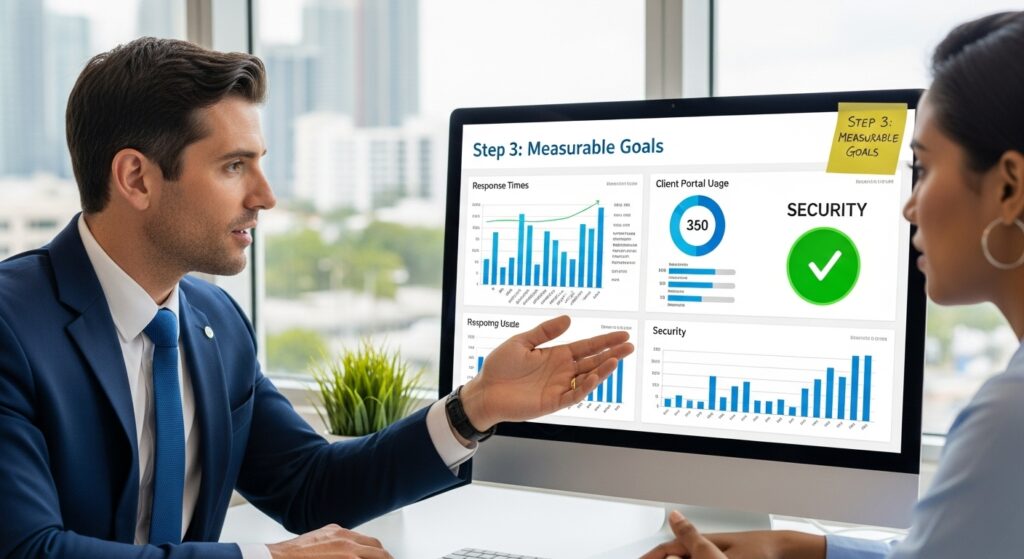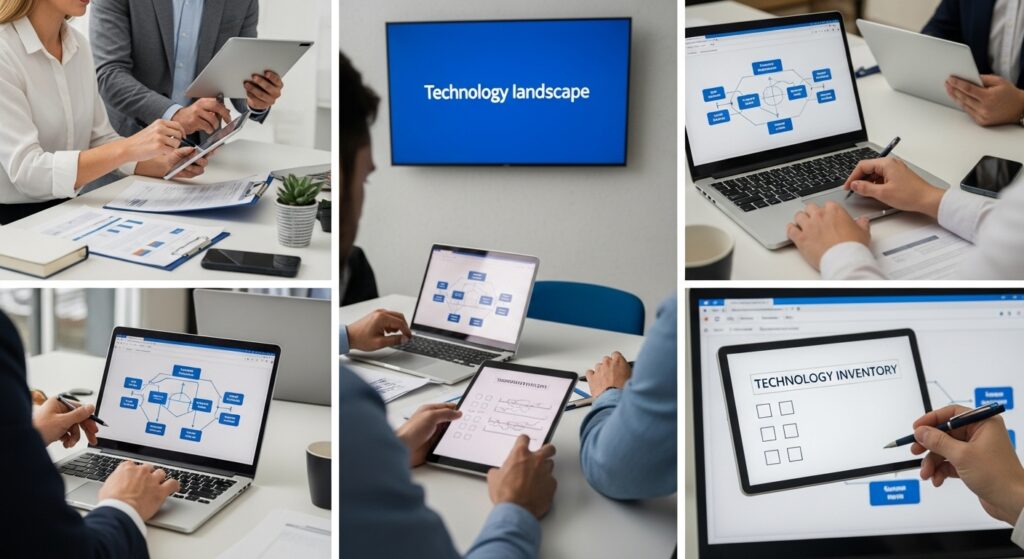Every Miami CPA firm wants to be known for precision and client trust, but technology has become the real make-or-break factor in this race. Surprisingly, even though nearly 60 percent of accounting firms report technology as their single biggest barrier to growth, most still overlook essential steps when mapping out their IT strategy. This gap is not just about outdated software or slow computers. What actually sets successful firms apart is how they use targeted feedback and measurable goals to turn technology into a true competitive advantage.
Quick Summary
Key PointExplanation1. Conduct a thorough tech inventoryDocument all current hardware, software, and systems to understand your technological resources and inefficiencies.2. Define your target clients uniquelyIdentify and analyze the specific technological needs of diverse client segments in Miami’s accounting market.3. Set SMART technological goalsCreate specific, measurable, achievable, relevant, and time-bound objectives that align with business growth and client satisfaction.4. Create a detailed action planOutline specific tasks with timelines, resources, and responsibilities to achieve your IT strategy goals effectively.5. Continuously analyze and adjustGather feedback and performance data regularly for ongoing improvements to keep your IT strategy responsive and effective.
Step 1: Assess Your Current Business Landscape
Building an effective IT strategy for Miami CPA firms starts with a comprehensive assessment of your current business landscape. This initial step is crucial because understanding your existing technological infrastructure, operational challenges, and strategic goals will guide every subsequent decision in your IT roadmap.
Know Your Technology Ecosystem
Start by conducting a thorough inventory of your current technological resources. This means documenting every piece of hardware, software, network configuration, and digital tool your accounting practice currently uses. Pay special attention to your accounting software, client management systems, data storage solutions, cybersecurity measures, and communication platforms.
Miami CPA firms often operate in a complex digital environment, juggling multiple client needs, regulatory compliance requirements, and data protection standards. Your technology assessment should reveal not just what systems you have, but how effectively they’re supporting your business objectives. Look for inefficiencies, bottlenecks, and potential vulnerabilities in your current setup.
Performance and Compatibility Analysis
Evaluate the performance of your existing technology infrastructure. Are your systems running smoothly? Do you experience frequent downtime or slow processing speeds? Are your current tools fully compatible with each other, or do they create friction in your workflow?
Consider key performance indicators such as system response times, data transfer speeds, user accessibility, and integration capabilities. For accounting firms, this means assessing how quickly you can generate reports, process client information, and maintain secure data repositories. A comprehensive performance analysis will help you identify which technologies are serving you well and which need immediate replacement or significant upgrades.
To successfully complete this assessment, document every finding meticulously. Create a detailed report that includes:
- Current hardware inventory
- Software licenses and versions
- Network infrastructure details
- Existing cybersecurity protocols
- Performance metrics
- Identified technological gaps
This initial assessment provides the foundation for developing a strategic, forward-thinking IT plan that aligns perfectly with your Miami CPA firm’s unique operational needs and growth objectives.
Step 2: Define Your Target Audience and Services
After assessing your current technological landscape, the next critical step in building an effective IT strategy for Miami CPA firms is defining your target audience and service offerings with laser precision. This step transforms your technological understanding into a strategic roadmap that directly addresses your clients’ specific needs.
Understanding Your Miami Accounting Market
Miami presents a unique accounting ecosystem with diverse client segments. Your IT strategy must reflect the nuanced requirements of different professional groups. Consider the varied landscape: multinational corporations in Downtown Miami, family-owned businesses in Little Havana, real estate investors in Coral Gables, hospitality enterprises near Miami Beach, and startup entrepreneurs in Wynwood.
To effectively define your target audience, you need more than surface-level demographic information. Dive deep into understanding their technological comfort levels, compliance requirements, and specific pain points. A tech-savvy startup will have radically different IT needs compared to a traditional family accounting practice. Some clients might require robust cloud storage and remote collaboration tools, while others might prioritize ironclad cybersecurity and local data management.
Mapping Services to Client Technological Expectations
Translate your audience insights into precise service offerings. This means creating technology solutions that directly address client challenges. For a Miami real estate accounting firm, this might involve specialized data integration tools that connect property management software, tax reporting platforms, and financial tracking systems. For a multilingual practice serving Miami’s diverse communities, this could mean developing bilingual client portals with seamless translation capabilities.
Your service definition should include clear technological capabilities that set you apart. Consider creating service packages that highlight your unique IT infrastructure:
- Guaranteed 15-minute response times for urgent financial queries
- 99.99% system uptime for uninterrupted financial management
- Advanced cybersecurity protocols protecting sensitive client data
- Seamless integration with multiple accounting and tax preparation platforms
- Customizable reporting tools adaptable to different industry requirements
Successfully completing this step means having a crystal-clear document that outlines your target client segments, their specific technological needs, and the precise IT services you will offer to meet those needs. This strategic definition becomes the blueprint for your entire IT strategy, ensuring that every technological investment directly supports your business growth and client satisfaction.
Step 3: Develop Measurable Goals and Objectives
Transforming your technological assessment and audience understanding into a concrete IT strategy requires developing clear, measurable goals and objectives. This step is the strategic bridge that connects your current technological landscape with your future business aspirations.
Crafting Strategic IT Objectives
Goals in an IT strategy for Miami CPA firms must go beyond generic statements. They need to be specific, quantifiable, and directly aligned with your business growth and client service improvement. Think of these objectives as precise targets that transform your technological capabilities from passive infrastructure to active business enablers.
Start by breaking down your broader business vision into granular, achievable technological objectives. For a Miami accounting practice, this might mean setting goals like reducing client data processing time by 40%, improving system security to prevent 99% of potential cyber threats, or creating a client portal that increases remote service accessibility by 60%.
Implementing a Measurement Framework
To make your goals truly effective, you need a robust measurement framework. According to Harvard Business School, this involves creating a balanced approach that tracks not just financial metrics, but also customer satisfaction, internal process efficiency, and technological learning and development.
Your measurement framework should include specific key performance indicators (KPIs) that allow you to track progress objectively. These might include metrics like:
- Average system response time
- Number of successful client data migrations
- Percentage of automated reporting processes
- Client satisfaction scores related to technological service
- Reduction in potential security vulnerabilities
Each objective should follow the SMART principle: Specific, Measurable, Achievable, Relevant, and Time-bound.
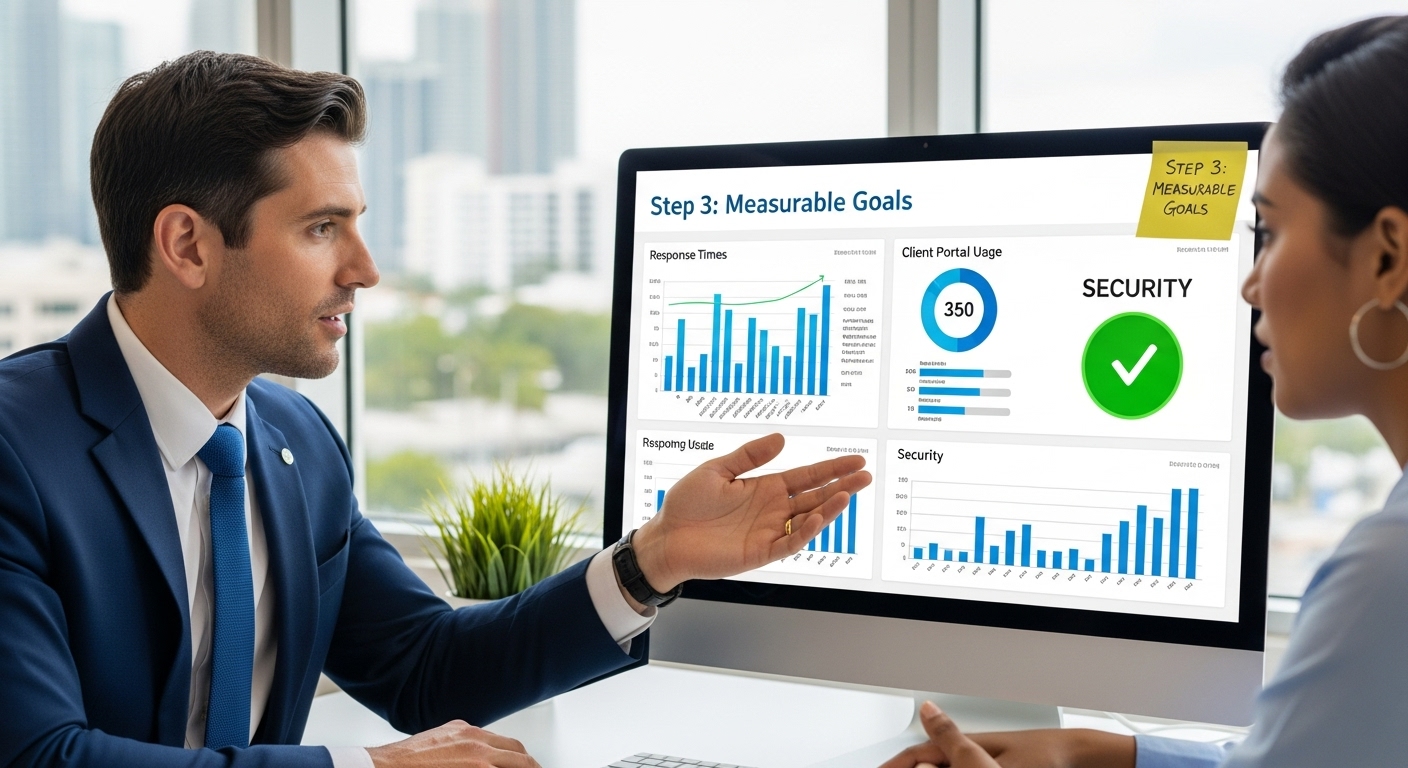
For instance, instead of a vague goal like ‘improve cybersecurity,’ a SMART objective would be ‘Reduce potential security breaches by implementing advanced encryption protocols across all client management systems within six months, targeting a 95% reduction in identified vulnerabilities.’
Successfully completing this step means having a comprehensive document that outlines your technological objectives, complete with clear metrics, timeline, and expected outcomes. This becomes your strategic roadmap, guiding every technological investment and decision for your Miami CPA firm.
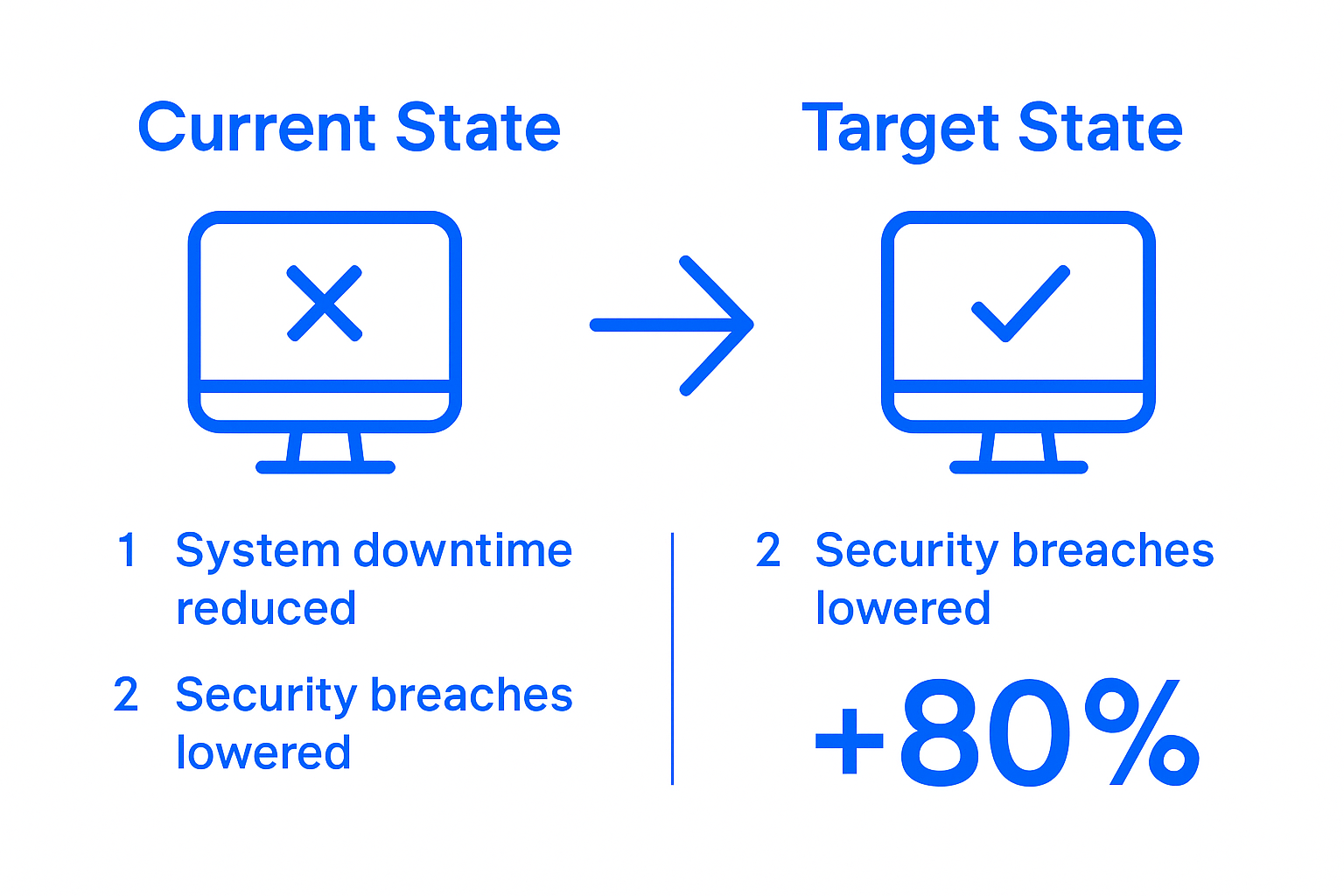
Step 4: Create a Detailed Action Plan
With your goals and objectives clearly defined, the next critical step is transforming strategic vision into a concrete, actionable roadmap. A detailed action plan serves as the operational blueprint that will guide your Miami CPA firm’s technological transformation, ensuring every technological investment and implementation aligns with your broader business objectives.
Mapping Technological Interventions
Building an effective action plan requires meticulous detail and strategic thinking. Break down each technological objective into granular, manageable tasks with precise timelines, assigned responsibilities, and required resources. This means creating a comprehensive document that outlines exactly how you will achieve each technological goal, from initial implementation to final verification.
Consider the specific technological interventions needed for your accounting practice. This might involve selecting and integrating new software platforms, upgrading existing infrastructure, implementing advanced cybersecurity protocols, or developing custom client management solutions. Each intervention should have a clear sequence of actions, estimated duration, budget allocation, and designated team members responsible for execution.
Resource Allocation and Risk Management
According to U.S. Small Business Administration, successful action plans require comprehensive resource mapping and proactive risk management. Your plan should transparently outline the financial, human, and technological resources required for each technological initiative.
Identify potential challenges and develop mitigation strategies in advance. For a Miami CPA firm, this might include:
- Potential software integration complexities
- Staff training requirements for new technological systems
- Cybersecurity transition challenges
- Potential client communication and adaptation periods
- Budget constraints and financial planning
Your action plan should also include contingency measures. This means developing alternative approaches if initial implementations encounter unexpected obstacles. Build flexibility into your strategy, allowing for adjustments without compromising your overall technological objectives.
Below is a table summarizing key technological interventions that Miami CPA firms may implement as part of their IT action plan, along with their main purposes and considerations.
Technological InterventionMain PurposeKey ConsiderationsNew Software IntegrationEnhance efficiency and automate workflowsCompatibility, staff training needsInfrastructure UpgradesImprove speed, reliability, and scalabilityBudget constraints, minimal downtimeAdvanced Cybersecurity ProtocolsProtect sensitive client and business dataCompliance, staff adaptationCustom Client Management SolutionsTailor service delivery to specific client needsCustomization, future scalabilityCloud Storage DeploymentEnable remote access and data backupSecurity, access controlAutomated Reporting ToolsStreamline financial report creationUser training, integration with systemsBilingual Client PortalsServe Miami’s diverse client baseAccurate translation, user experience
Successfully completing this step means producing a comprehensive, living document that serves as your technological transformation roadmap. This plan should be detailed enough to guide immediate actions while remaining adaptable to emerging technological trends and business needs. Regular review and refinement will ensure your IT strategy remains dynamic and aligned with your Miami CPA firm’s evolving requirements.
Step 5: Analyze and Adjust Based on Feedback
Developing an effective IT strategy for Miami CPA firms is not a one-time event but a continuous, dynamic process. The final critical step involves systematically analyzing performance, collecting targeted feedback, and making strategic adjustments that keep your technological infrastructure responsive and cutting-edge.
Creating a Feedback Ecosystem
Feedback is the lifeblood of technological innovation, particularly in the fast-evolving accounting sector. Establish multiple channels to gather insights from different stakeholders: your team members, clients, and technological partners. This means creating structured mechanisms that encourage honest, constructive input about your IT systems’ performance, usability, and effectiveness.
For a Miami CPA firm, this might involve quarterly technology satisfaction surveys, regular team roundtable discussions, client feedback sessions, and ongoing performance metric reviews. The goal is to create an environment where technological improvements are driven by real-world experiences and emerging needs, not just theoretical planning.
Implementing Data-Driven Refinement
According to Community Tool Box, effective feedback processes require systematic analysis and actionable insights. This means developing a robust framework for collecting, categorizing, and responding to technological performance data.
Your refinement process should include comprehensive tracking of key performance indicators:
- Client satisfaction rates with technological services
- System reliability and uptime percentages
- Response times for technical support
- Cybersecurity incident frequencies
- Software integration effectiveness
- Team productivity metrics related to technological tools
Make your adjustment process transparent and collaborative. When you identify areas for improvement, communicate clearly with your team and clients about planned technological enhancements.
The following table highlights common performance metrics and feedback data Miami CPA firms should track to support continuous IT strategy improvement.
Feedback/Performance MetricWhat It MeasuresFrequency of ReviewClient Satisfaction RatesEffectiveness and usability of IT servicesQuarterlySystem Reliability/Uptime PercentageConsistency and dependability of digital systemsMonthlyTechnical Support Response TimeSpeed of resolving tech issues for clientsMonthlyCybersecurity Incident FrequencyOccurrence of security issues or breachesOngoing/As neededSoftware Integration EffectivenessSeamlessness of connecting new/existing systemsAfter each implementationTeam Productivity with Tech ToolsImpact of technology on staff efficiencyQuarterly
Successfully completing this step means developing a living, adaptive IT strategy that can quickly respond to changing technological landscapes, client needs, and emerging accounting industry trends. Your goal is to create a flexible technological framework that positions your Miami CPA firm as an innovative, client-focused practice ready to meet future challenges head-on.
Ready to Turn Your Miami CPA IT Strategy Into Measurable Results?
You have already learned how critical it is to map your technology, define client-specific services, and set clear, measurable objectives. Yet, knowing what to do is just the starting line. Many Miami CPA firms get stuck turning these plans into reliable, secure, and efficient systems that actually keep client data safe and compliance airtight. If you are worried about gaps in your current IT setup or want to ensure every objective from your roadmap becomes reality, you deserve a team that delivers on your goals with total confidence. Our proven 99.99% uptime, guaranteed 15-minute support response, and robust compliance focus mean you never risk falling behind or exposing your firm to costly downtime or penalties.
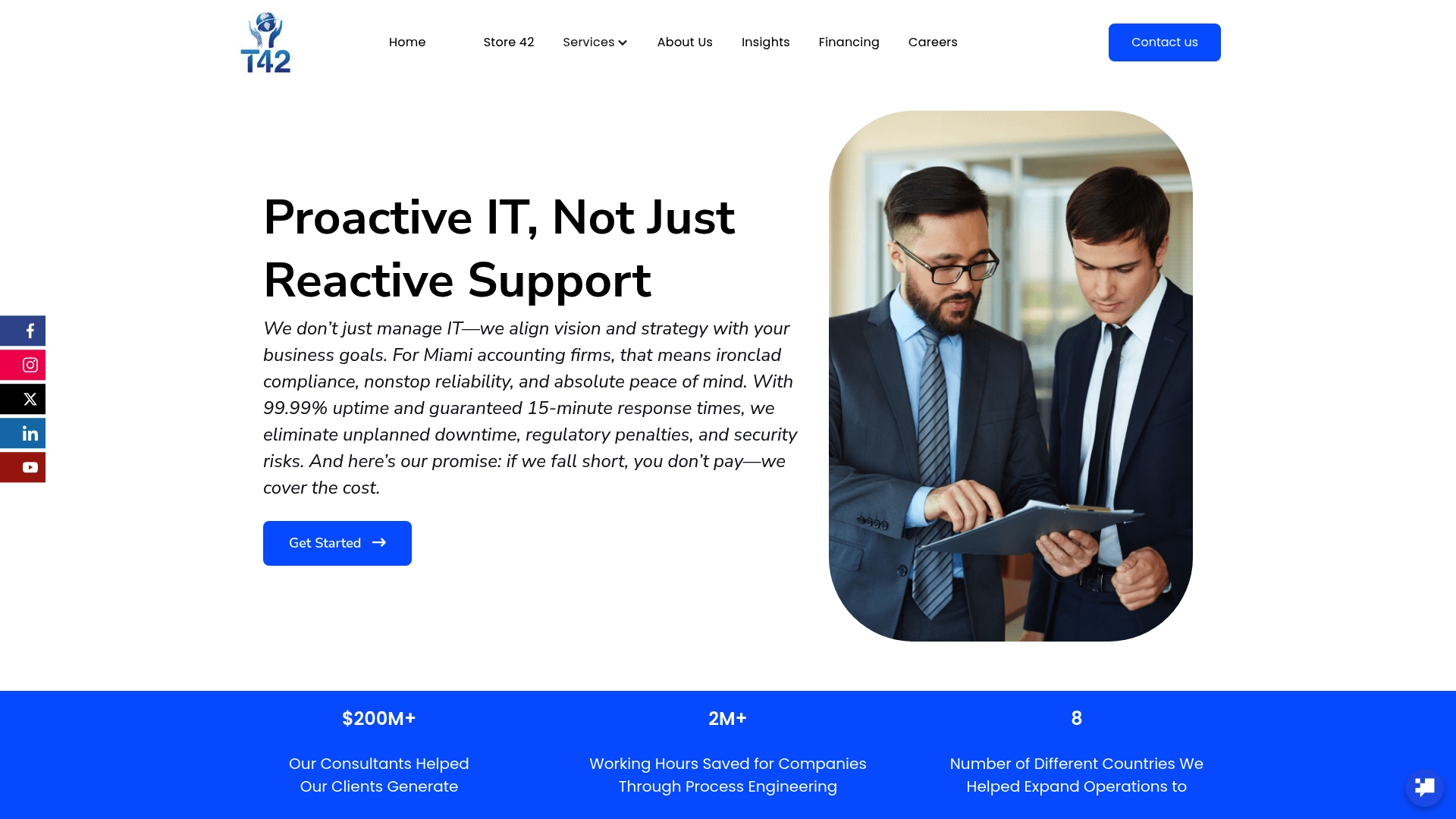
Let us help you bridge the gap from strategy to transformation today. Discover the difference at Transform42 and see how our approach to IT strategy turns planning into real business growth. Ready to experience IT that truly aligns with your vision? Visit https://www.transform42inc.com/ and connect for a custom consultation—with zero risk and our performance promise. Act now to futureproof your Miami CPA firm and stay ahead of the next compliance challenge.
Frequently Asked Questions
What is the first step in building an IT strategy for CPA firms?
The first step is to assess your current business landscape by conducting a comprehensive evaluation of your existing technological infrastructure, operational challenges, and strategic goals.
How can CPA firms define their target audience and services when creating an IT strategy?
CPA firms can define their target audience by understanding the specific needs, technological comfort levels, and compliance requirements of different client segments and then mapping their services to meet those needs.
What does setting measurable goals and objectives entail in an IT strategy?
Setting measurable goals and objectives involves creating specific, quantifiable targets that align with business growth and client service improvements, utilizing the SMART criteria to ensure they are specific, measurable, achievable, relevant, and time-bound.
How should a CPA firm create a detailed action plan for its IT strategy?
A detailed action plan should break down each technological objective into manageable tasks, outlining timelines, responsibilities, and resources needed to achieve each objective while also addressing potential risks and contingency measures.
Recommended
- Business Process Operations & Mapping Services | Transform 42 Inc.
- Real Estate and Development | Commercial Industrial Real Estate Management
- Financial Consulting and Finance Advisory | Automated Financial Systems | Transform 42 Inc.
- Vendor Management, Invoice & Inventory Solutions | Transform 42 Inc.
- Quality, Quantity or Both? – ST8

